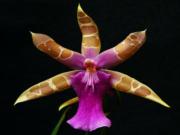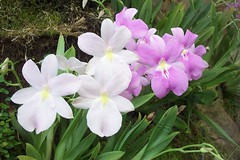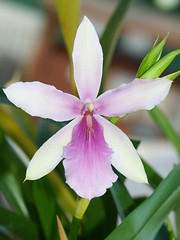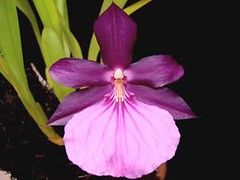When people talk about Miltonia orchids, they usually refer to both Miltonia and Miltoniopsis orchids. The reality is that these two types of orchids come from different places and have almost opposite requirements in temperature and light. People also use the nick name “pansy orchid” to refer to both Miltonia and Miltoniopsis, but in fact Miltonia species looks nothing like the garden flower pansy. Miltoniopsis is the one that look like the sweet-looking pansy.
Why the confusion? Because some time ago, these two orchids belong to the same genus, Miltonia. Growers distinguished the two by referring to the now Miltoniopsis as “cool-growing” or “Columbian” Miltonia, even though Miltoniopsis orchids are not necessarily cool growing nor from Columbia. Then one day, some taxonomists say, “Enough is enough!” and created the genus Miltoniopsis. But you think that solved the confusion problem? Nothing is that straightforward in the taxonomy world! After the separation, the hybrids between Miltoniopsis and Miltonia orchids retain the name Miltonia, even when some of them clearly have Miltoniopsis heritage and have the pansy appearance.
Miltonia vs. Miltoniopsis
You may say, a rose by any other name would smell as sweet (or an orchid by any other name would look as beautiful, in this case). Why do the names matter? Well, no, they don’t, except that to provide the appropriate growing condition, you do need to understand the type of orchid you are dealing with.
However, don’t distress. It’s quite easy to tell Miltonia from Miltoniopsis. Miltonia orchids have two leaves on each of the pseudobulbs, but Miltoniopsis orchids have one. Also, Miltoniopsis have flatter pseudobulbs that cluster together closely, whereas Miltonia have rounder pseudobulbs that are farther away from each other. Moreover, Miltoniopsis flowers are pansy-like. Therefore, even if you get a hybrid that has the name Miltonia on the tag, if it has the Miltoniopsis attributes, then you should treat it like Miltoniopsis.
How to Grow Miltonia
All nine species of Miltonia orchids are found in Brazil, but some are also found in Argentina, Paraguay and Peru. In their natural habitat, the fragrant orchids are bathed in rain, fog and mist, and they do not experience any dry period at all. Therefore, you have to make sure that your Miltonia stay moist at all time. Nonetheless, your potting medium should not be soggy, as it will promote rotting. Add charcoals and perlite along with bark or sphagnum moss in your potting mix to promote drainage. The ideal humidity should be between 80 to 85%. With such high humidity, it is extremely important to keep the air moving to prevent diseases. If your Miltonia does not have enough water or the humidity is too low, the new leaves will be pleated like an accordion. Even when you water it more or keep it in higher humidity from then on, those leaves will remain pleated, but the new ones will be normal.
Miltonias prefer intermediate light level (1500 to 3000 foot-candles), similar to the need of Cattleya orchids. If you are growing them indoors, put them by an east-, south- or west-facing window, but shade it from direct sunlight with a screen or a piece of chiffon to prevent any burning of the leaves. The higher the light your Miltonia receives, the lighter the leaves will be, so much so that they may look yellow. Light-color leaves are not necessarily a sign of unhealthy orchids, but most people prefer their orchids to be green rather than yellow. Moreover, you need to provide lots of air movement when the sun is strong, so that the light will not burn your precious orchid. A personal small fan will suffice.
Miltonia orchids enjoy intermediate temperature. In the summer, grow them at 74-78°F (24-26°C) during the day and 61-63°F (16-17°C) at night. In the winter, you can grow them at 65-66°F (18-19°C) during the day and 52-53°F (11-12°C) at night.
With their fine roots, Miltonia is sensitive to fertilizer. So fertilize it weakly weekly at a quarter of the recommended strength when the plant is actively growing. Be sure to flush out the medium every few weeks to get rid of excess fertilizer that is not used by the plant. This is particularly important if your water has high mineral content.
Because Miltonia orchids tend to creep and climb as they grow (as opposed to the pseudobulbs cluster together), it’s almost impossible to contain them in pots. The easiest thing to do is to grow them in baskets loosely filled with sphagnum moss. But the disadvantage is that they will dry out faster and the moss breaks down more quickly, requiring repotting every 12 months or so. If you live in a very humid place and can water your Miltonias several times a day (or use a timer-operated mister), you can even mount them on pieces of bark or tree fern, and let the free spirits climb and creep as they wishes.
Happy growing!




